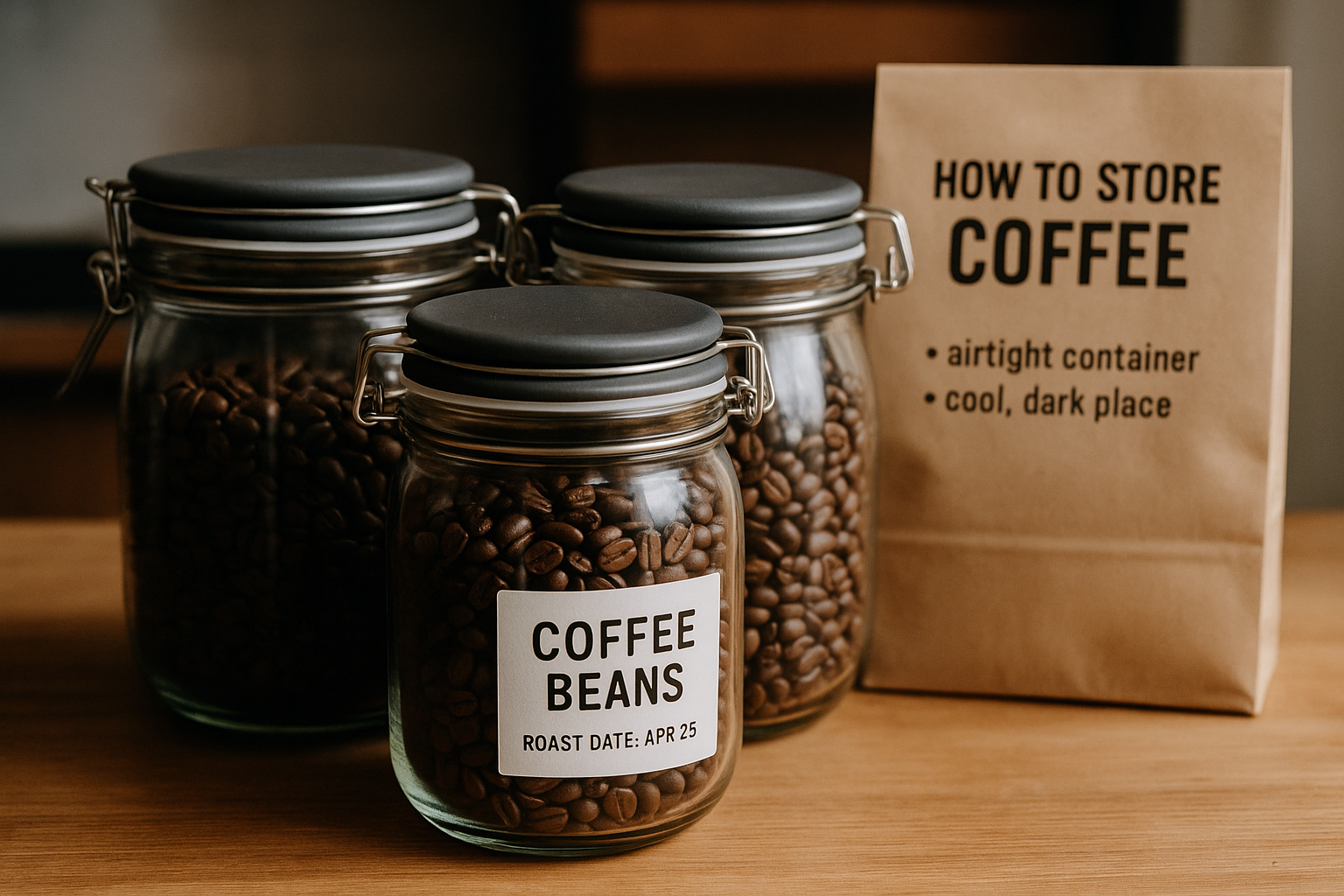As a barista, your attention to detail doesn’t stop at the espresso machine.
The way you store your coffee beans has a massive impact on the flavor, aroma, and quality of every drink you serve. Even the best beans in the world can lose their brilliance if mishandled after roasting.
Understanding and implementing proper storage techniques ensures that your coffee stays as fresh and expressive as possible, preserving all the care that farmers, processors, and roasters put into those beans.
What Happens to Coffee After Roasting?
Once roasted, coffee becomes highly sensitive to air, moisture, light, and temperature. The chemical compounds responsible for aroma and flavor begin to break down.
The four biggest threats to coffee freshness are:
- Oxygen: Causes oxidation, dulling flavors.
- Moisture: Introduces mold risk and affects extraction.
- Heat: Speeds up degradation of oils and aromatics.
- Light: Breaks down flavor compounds, especially UV rays.
Roasted coffee is not a long-term shelf-stable product. Its freshness begins to degrade as soon as it’s exposed to air. That’s why knowing how to store it properly is a vital skill for every barista.
The Ideal Storage Environment
To maximize freshness, coffee should be stored in a cool, dark, and dry place, ideally in an airtight container. Aim for the following conditions:
- Temperature: Between 18–24°C (64–75°F), avoiding fluctuation.
- Humidity: Below 60% to prevent moisture absorption.
- Light: Keep away from direct sunlight or fluorescent lights.
- Air Exposure: Minimize to prevent oxidation.
If your café has inconsistent climate control or fluctuating temperatures (like near ovens or windows), use extra protection like vacuum-sealed containers or nitrogen-flushed packaging.
Choosing the Right Coffee Storage Containers
The container you use can either protect or expose your beans to damaging elements. Look for containers that offer:
- Airtight seals: To prevent oxygen from entering.
- Opaque material: To block light.
- One-way degassing valves: Useful for freshly roasted beans still releasing CO₂.
- Food-grade quality: Always use safe, non-reactive materials like stainless steel or ceramic.
Avoid storing beans in paper bags or clear plastic containers, especially once the original packaging is opened. If you’re reusing containers, clean them regularly to avoid old oil and flavor residue contaminating fresh coffee.
Should You Store Coffee in the Fridge or Freezer?
This is a common debate, and the answer depends on how you’re doing it.
Fridge
Generally not recommended. The fridge has high humidity and fluctuating temperatures. Coffee can absorb odors from other foods and develop condensation that damages the beans.
Freezer
Can be a good option if done right. Freezing slows down chemical degradation, especially for long-term storage. But you must:
- Use vacuum-sealed bags or containers
- Portion out the coffee before freezing
- Avoid repeated thawing and refreezing
For baristas, freezing is most useful for storing rare or competition coffees, not for daily café use.
Understanding Roast Date and Degassing
Freshly roasted coffee goes through degassing, where CO₂ escapes from the beans. This gas can affect flavor and extraction if used too soon—especially in espresso.
- Espresso: Best used 7–14 days post-roast.
- Filter brews: Can be used after 3–10 days.
Always check the roast date and plan usage accordingly. Don’t grind or brew beans immediately after roasting. Let them rest for a balanced and stable profile.
How Long Does Coffee Stay Fresh?
There is no single expiration date for roasted coffee. Instead, it’s about peak freshness—the window where the coffee tastes its best.
- Whole beans: Maintain peak flavor for 2–4 weeks after roast when stored properly.
- Ground coffee: Begins to lose aroma and complexity within minutes to hours.
After the peak window, coffee won’t become harmful, but it will become flat, woody, or stale. As a barista, you should taste and monitor your inventory often to ensure quality.
Managing Café Inventory for Freshness
In a professional setting, managing stock is as important as storing it correctly. Follow these best practices:
- First In, First Out (FIFO): Use older roasts before newer ones.
- Label everything with roast dates.
- Keep daily logs of bean usage and bag openings.
- Order in smaller, more frequent batches when possible.
- Communicate with your roaster about projected usage.
These systems help avoid waste and ensure that customers are always getting coffee at its best.
Grinding and Storage: The Freshness Equation
Grinding dramatically accelerates coffee degradation. Pre-ground coffee loses 60–70% of its aromatics in the first 15 minutes after grinding.
- Always grind fresh if possible.
- If pre-grinding is necessary, do it in small daily batches and store in airtight, opaque containers.
- Label ground containers with grind date, grind size, and intended use (espresso, pour-over, etc.)
Baristas must train themselves to recognize the difference between fresh and stale ground coffee—it affects everything from crema quality to aftertaste.
Educating Customers About Coffee Storage
Many customers store their coffee improperly at home. As a barista, you can add value by sharing simple tips:
- “Keep it in a sealed container away from sunlight.”
- “Don’t store it in the fridge unless it’s vacuum-sealed.”
- “Grind only what you’ll brew right away.”
You can even sell branded airtight containers or offer freshness guides. Empowering your customers deepens their appreciation—and strengthens your café’s credibility.
Signs of Stale Coffee and What to Do
Knowing how to spot stale coffee is crucial for quality control. Look out for:
- Faded or “flat” aroma in ground coffee.
- Woody or papery taste in brewed cups.
- Lack of crema in espresso.
- Excessively fast or slow extraction.
- Dull, dry-looking beans with faded color.
If a batch has gone stale, don’t serve it. Repurpose it for training, cleaning grinders, or composting. Never compromise your café’s quality standards—your regulars will notice.
Specialty Packaging: Nitrogen, Valves, and More
Some roasters go the extra mile with high-tech packaging. Here’s what you should know:
- Nitrogen flushing: Removes oxygen before sealing to extend shelf life.
- One-way valves: Allow gas to escape but keep air out. Ideal for degassing fresh coffee.
- Vacuum-sealed bricks: Great for bulk storage, often used by restaurants or hotels.
While these don’t replace proper storage, they provide an additional layer of protection. Baristas should understand the science behind the packaging to better explain value to customers.
Coffee Storage in Extreme Climates
If your café is in a hot or humid region, invest in:
- Climate-controlled storage rooms or cabinets.
- Vacuum containers with humidity packs.
- Digital thermometers and hygrometers to monitor conditions.
In colder climates, avoid placing coffee near heaters or windowsills. Stability is key—beans age faster when temperatures fluctuate wildly.
Final Thoughts: Treat Coffee Like a Fresh Ingredient
Coffee is perishable, delicate, and dynamic. It should be treated with the same respect as fresh produce, herbs, or fine chocolate. Great baristas never take their beans for granted.
Proper storage is not just a technical detail—it’s part of delivering quality, honoring the supply chain, and building a reputation for consistency.
Remember: every time you open a bag, you’re unlocking potential—or letting it fade. Make that moment count.

Artur is a coffee enthusiast and content creator passionate about barista techniques and coffee culture. With a sharp eye for detail and a love for learning, he shares practical tips, brewing guides, and gear insights to help readers elevate their coffee experience — from home brewers to aspiring professionals.
